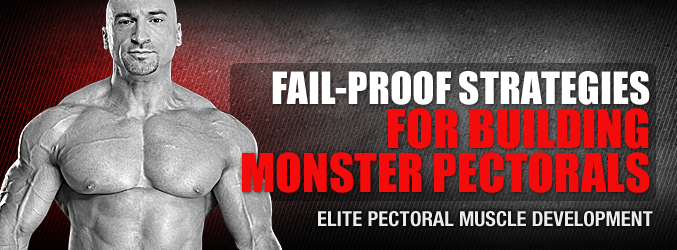
The devil is in the details.
Ask any lawyer about what kind of magic a misplaced comma in a contract can wreak upon construction of a multi-million dollar skyscraper. Ask any fighter pilot what a fraction of an inch matters in a dogfight at 500+ miles per hour. And, for our purposes, ask any champion level bodybuilder what kind of impact a few minor, often overlooked subtleties can have upon overall chest training and development.
Repetition speed
We count the weight we lift. We count how many sets and repetitions we use. We count how much time between sets, how many exercises to use, and about a dozen other things when we train chest. But have you ever counted the number of seconds you spend pushing the weight up on chest movements, and lowering the weight down?
Most lifters will move the weight as fast as they can, resulting in a situation where inertia and momentum carry much of the weight – and not the targeted muscles! And while we’re on the subject, you should consider PAUSING at the start point of each repetition. Remove momentum entirely from the equation, forcing your muscles to do the bulk of the work!
You should employ a 2/4/1 technique for pressing. Spend 2 seconds pressing the weight up, another 4 seconds lowering the weight (for strength gain targeting), and one full second paused at the bottom.
You’ll be more sore than you’ve ever been before, but the growth you see in the coming days will make it very much worth it!

Your goal… make it clearer
Most lifters attend the gym for decades, hitting chest every Monday. But they never make a very critical clarification – one that you should learn to define, today! Are you in the gym to “lift weight” or are you in the gym to “train the pectorals”. Re-read that a few times and let the connotations really sink in.
If you’re here to lift, then your goal is to move more weight from point A to point B. You’re all about rushing, shoving weights, and again, letting momentum allow you to move more weight. On the other hand, if your clearly stated goal is to “train the pectorals”, then the amount of weight that you move will be inconsequential. Only the stimulation that your pectoral muscles receive (as a result of working the muscle fibers) will matter.
Your entire training style will be slower and more controlled. You won’t care if you get that extra repetition because the previous 9 repetitions were more productive and useful for chest muscle fiber stimulation than any training you’ve ever seen before. Define your goals this way – you’re about chest stimulation, and not moving metal.

All about that incline
The perfect chest is tall, thick, and square, completely filling out the upper area all the way from the sternum to the collarbone. That is a bodybuilding chest.
A powerlifter chest (designed only to move heavy amounts of weight) is much thicker in the lower areas, bunched up with little aesthetic value and plenty of thick bulk for moving the numbers. If your clearly stated goal is to possess an incredible and complete chest, then you’ll want to focus much more upon the upper chest movements.
Incline bench press, incline dumbbell press, incline Smith machine, incline DB flyes… well, you get the idea! Enjoy a 3:1 ratio for upper:lower chest exercises and you too will have a thick upper chest. Whether you can ever stand a glass of water upon your chest shelf, as Arnold Schwarzenegger could do in his prime… well, that’s up to you!

Leaving the shoulders & triceps at home
The goal of chest day is to, well, train the chest. Your mission is to simulate the muscle fibers of the chest so that they grow. While the shoulder and triceps muscles are used extensively in a supporting role when training chest, your goal isn’t to train them.
In fact, you may fare better if another of your stated goals for chest-training day is “to involve the shoulders and triceps as LITTLE as possible!” If this is a problem for you, use pre-exhaust to isolate the chest first. Try incline DB flyes to hit the chest muscles only, followed with your standard benching and dumbbell presses.
Your chest fibers will already be exhausted y the end of set #1, which means they’ll be doing more work during set #2. Don’t worry about triceps & shoulders – they have their own training days when you can give them plenty of attention!


